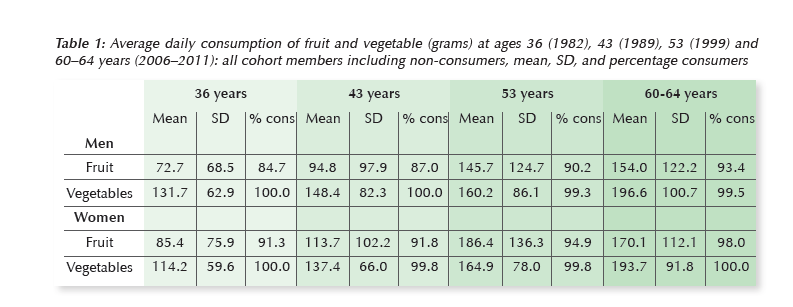Trends in food consumption over 30 years in British Focus on Fruit and Vegetables intake
Over the past decades, food consumption patterns and food availability have changed drastically. This study aims to provide a comprehensive overview of changes in food consumption during 30 years of follow-up in the British birth cohort from the Medical Research Council National Survey of Health and Development. The Medical Research Council National Survey of Health and Development (NSHD; 1946 British Birth Cohort) is the longest running birth cohort in the world and is unique in having collected detailed dietary information at a number of time points through the life course1.
Methods
Dietary intakes were assessed using a 5-day estimated diet diaries. Only those who recorded ≥3 days at all four time points were included in the analyses. Dietary data of 989 participants (n = 438 men and n = 551 women) were collected at:
- 36 years (1982),
- 43 years (1989),
- 53 years (1999) and
- 60–64 years (2006–11).
All food and drinks consumed both at home and away were recorded using household measures, and portion sizes were estimated using detailed guidance notes and photographs provided at the beginning of the diary2. Trends were tested using the Friedman test.
Results
In this ageing cohort, the changes in food consumption that were observed reflect a diet of improved diet quality, as indicated by changes such as replacement of white bread by granary and whole meal bread, lower consumption of red and processed meats, coffee, sugar and confectionery and higher consumption of fruit, vegetables and fish.
Few differences occurred between men and women, with the most striking difference being related to drink consumption: men consumed more alcoholic drinks than women; however, women at 60–64 years tended to drink more alcoholic drinks than previously, whereas men showed a small decrease in alcoholic drinks.
Energy intake changed over time, with the highest mean energy intake reported at the age of 43 years in both men and women. Moreover, in this cohort the percentage of current smokers decreased with time and the percentage of physical inactivity increased with time, as did body mass index.
The consumption of fruit and vegetables has increased from 1982 to 2006-11: more than 70% for vegetables and 100% for fruits
Data on fruit and vegetable consumption for men and women are presented in Table 1.
From 1982 to 2006-11, the average consumption of total vegetables (excluding potatoes) increased from 132 to 197g per day for men and from 114 to 194g per day for women. All cohort members reported eating some vegetables during the five days of recording at all four time points. Over 90% of cohort members consumed potatoes; the average weight of potatoes consumed per day decreased since 36 years, and the consumption of potato products increased in both men and women. The consumption of total fruit had almost doubled since 36 years from 72.7g/day for men and 85.4g/day for women to 154g/day for men and 170g/day for women aged 60–64 years. At this most recent age, most cohort members reported consuming fruit over the 5-day recording period: 93% of men and 98% of women. This percentage increased since the age of 36 years, especially in men (from 85% at age 36 years) but not so much for women (92% at age 36 years).

Based on: Pot GK, Prynne CJ, Almoosawi S, Kuh D, Stephen AM. Trends in food consumption over 30 years: evidence from a British birth cohort. Eur J Clin Nutr. 2014 Oct 29.
References
- Kuh D, Pierce M, Adams J, Deanfield J, Ekelund U, Friberg P et al. Cohort profile: updating the cohort profile for the MRC National Survey of Health and Development: a new clinic-based data collection for ageing research. Int J Epidemiol 2011; 40: e1–e9.
- Prynne CJ, Paul AA, Mishra GD, Greenberg DC, Wadsworth ME. Changes in intake of key nutrients over 17 years during adult life of a British birth cohort. Br J Nutr 2005; 94: 368–376.
